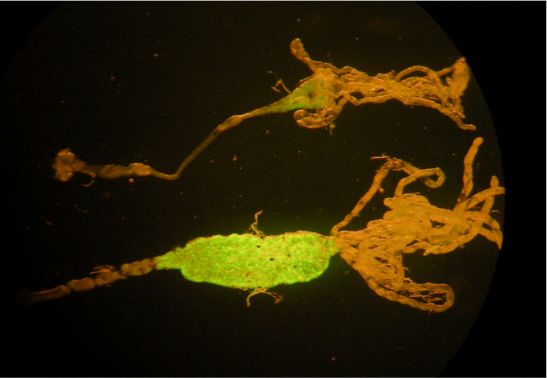
The Vector Biology Department has technical expertise in the development and utilisation of diagnostics for insecticide resistance in disease vectors. These encompass bioassays on a wide range of mosquito populations with differing insecticide resistance phenotypes (http://www.lite-testing-facility.com/), DNA based diagnostics for the detection of known resistance markers and RNA/Whole Genome Sequencing studies to uncover novel resistance mechanisms.
Our mosquito transgenics facility is used to functionally validate candidate genes and can also be used to produce bespoke mosquito lines, expressing one or more genes of interest in specific tissues. We have developed routine analysis of gene function in Anopheles gambiae through piggyBac transformation, PhiC31 mediated cassette exchange, Gal4/UAS, enhancer trapping and have initiated work with CRISPR/Cas9 to modify genomes at will.

Gal4/UAS driven transgene expression in adult mosquito midguts
We work closely with disease control programmes to provide technical assistance in monitoring and evaluation from the development and implementation of decision support systems to the provision of high throughput molecular processing of vector collections to determine species, source of bloodmeal and pathogen infection status.
Via strong links with industrial partners and IVCC (http://www.ivcc.com/) we are accelerating the product development pipeline for new public health insecticides by offering in vitro and in vivo screening tools to test new products for metabolic stability in insects and to help predict cross resistance profiles (see case study below). We have also pioneered the development and use of insecticide quantification kits (IQKs, simple visual assays for the rapid and reliable monitoring of DDT, carbamate and organophosphate used in Indoor Residual Spraying). These IQKs are being used in quality assurance studies in India and Africa and helping reduce wastage and improve health outcomes.
Finally, via our extensive networks of overseas partners, including a field station in Cameroon, we can offer facilities for screening new vector control products under natural settings, including standard World Health Organisation experimental huts.

Experimental field huts
Case Study
New Public Health Insecticides: An old solution for a very current problem?
The emergence and spread of high levels of resistance to insecticides used in public health is raising alarms about the sustainability of current interventions which are reliant on just a handful of insecticides. New insecticides for public health are under development but, despite significant investments of public and private money, it will be several years before these are in use in the field. There is therefore an urgent need for ‘stop gap’ measures, to ensure that current gains in malaria control are not jeopardised by insecticide resistance. Our research on the mechanisms responsible for pyrethroid resistance led to an observation that some pyrethroid resistant populations of mosquitoes are actually more susceptible to an organophosphate insecticide, malathion, which was used widely in the past but has now been largely superseded. We used a combination of bioassays in the lab and field, biochemical, molecular biology and transgenic approaches to confirm and characterise this ‘negative cross resistance’ between two existing insecticides. We are now determining whether this pattern is also true for other organophosphate insecticides in order to provide some short term solutions to control programmes facing potential control failure due to pyrethroid resistance.
Similar approaches can be adopted to look for examples of cross resistance (both negative and positive) between any insecticide class.
